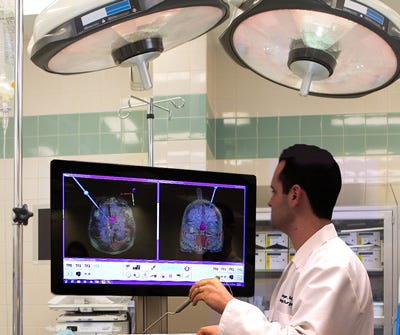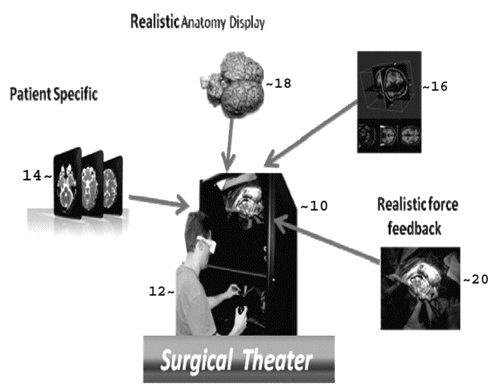They've had it in-flight simulators to help pilots train for life-or-death situations. Now 3-D and augmented reality is coming to another high stakes place--the operating room--after FDA clearance of Cleveland-based Surgical Theater's Surgical Navigation Advanced Platform (SNAP).
|
The technology from Surgical Theater was inspired by F-16 flight simulator software. |
The concept involves combining flight simulation technology with advanced CT/MRI imaging for use in brain surgery, according to Surgical Theater. The company's Surgical Rehearsal Platform (SRP) received FDA clearance last year when it came to providing a real-life "fly through" of a "patient-specific" surgery.
With the new FDA clearance, the Surgical Navigation Advanced Platform can now be also used in an operating room to help surgeons execute their surgery plan, using 3-D organ models created using a patient's CT/MRI scans. The system also takes into account the deformation that tissues may undergo in the procedure. For instance, in the case of cerebral aneurysm repair surgeries, the orientation of brain tissues can be distorted as the surgeon cuts and applies pressure to it, making it difficult to use CT or MRI scans.
Warren R. Selman, MD, chairman of the Department of Neurological Surgery at University Hospitals Case Medical Center in Cleveland, actually started Surgical Theater with two ex-Israeli Air Force R&D officers he met in a coffee shop in 2010, CNN reports. They were musing why flight simulator technology was not used to help surgeons prepare for difficult surgeries.
Selman is Surgical Theater's chief medical officer, while electrical and computer engineer Moty Avisar is president and software engineer Alon Geri is vice president of engineering.
University Hospitals Case Medical Center is now using SNAP as an integrated operating room device, Selman says.
"It is just like watching a football game when multiple cameras are located around the arena and an editor can freeze the image, rotate, zoom in, zoom out and see things that he could not otherwise see," Selman said in a news release. "In my recent surgeries, I was able to pause the navigation scene during the surgery to rotate the image and to verify that I removed the entire tumor and to make sure that I was within a safe distance from a vital artery while removing the tumor. With the SNAP connected to the OR navigation platform, the OR team coordination is enhanced, and we are utilizing the best imaging technology tool to benefit our patients."
One wonders what other types of risky surgeries, not to mention other medical procedures, might benefit from using 3-D and augmented reality to help health practitioners train, as well as guide them through procedure.
The SNAP technology works by leveraging several networked PCs that have dedicated tasks such as the processing of visual information, user-interface data, and so forth, according to Surgical Theater's patents. The strategy of tapping the processing capability of several PCs affords precise simulation fidelity of complex medical procedures such as aneurysm repair. In addition, it minimizes processing lag time, enabling the surgeons to be immersed in realistic surgical training.
This is made possible in part by proprietary algorithms that crunch the data from the samples, and then calculate the parameters of the data communicated across the system's network notes.
A patented modeling system synthesizes patient medical images of one or more organs with the system's database of model organ data. The system then uses this combined data to generate life-like dynamic images of the relevant organs. The software also is able to realistically model the characteristics of surgical tools, probes, and medical devices, and determine how those tools would interact with the relevant anatomy in a surgical procedure based on user input.
|
This high-level schematic of a hardware implementation is pulled from U.S. patent 12/907,285. |
Surgical Theater says on its website: "The software engineers that designed the SRP also developed the flight simulation technology used by F-16 fighter pilots. Surgical Theater's patented and FDA-cleared Surgical Rehearsal Platform is patient-specific allowing surgeons to be prepared for complicated cases in a similar way to how F-16 fighter pilots prepare for complicated missions."
It was also important to have a slim and robust cart for the OR, and an iPad displays the main screen image, "with full control capabilities and is ideal for remote use and viewing," according to Surgical Theater marketing materials about the device.
A virtual clip appears at the tip of the navigation probe for evaluation, the navigation image can be frozen and rotated to observe multiple points of view, and markers on the virtual clip allows for measuring of the neck and to fit a clip. There's also an adjustable virtual probe extension for stereotactic and trajectory planning.
Refresh your medical device industry knowledge at MEDevice San Diego, September 10-11, 2014. |
Chris Newmarker is senior editor of MPMN and Qmed. Follow him on Twitter at @newmarker. Brian Buntz is the editor-in-chief of MPMN and Qmed. Follow him on Twitter at @brian_buntz.
Like what you're reading? Subscribe to our daily e-newsletter.
About the Author(s)
You May Also Like


